By George Wellman
DC is famous for it’s cherry blossom trees, and we are lucky to have spectacular specimens on the Armed Forces Retirement Home (AFRH) campus.
The trees outside what we call “the Scott Artist Colony” are Yoshino cherry trees.
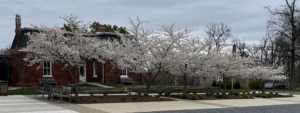
Yoshino cherry trees in bloom: March 2024
The saplings were cuttings from the 100-year-old cherry trees around the tidal basin here in Washington, DC. Volunteers planted the trees in 2012 during the 100th anniversary of the original cherry trees seen around the tidal basin. These donated cherry trees are no longer saplings because they are now 12 years old this year. They mimic the ones on the tidal basin as far as the blooming stages, color, and beauty. The photo below depicts our Yoshino trees in the stage just before peak bloom a few years ago. Peak bloom this year occurred on March 17th, the second earliest bloom in a century.
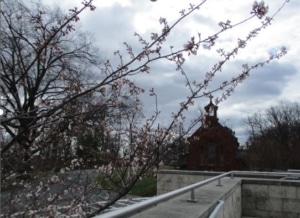
A budding Yoshino cherry tree on campus a little before peak bloom. Photo by George Wellman.
The cherry trees with the pink blossoms that are in bloom along Quarters Row at AFRH-West are Okame cherry trees. They normally bloom in late winter/early spring.
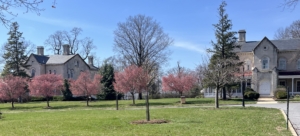
Okame cherry trees blooming in 2024.
Once again, the cherry trees on our campus are healthy and bloomed on schedule.
Other cherry trees in the Washington, DC, area include Kwanzan, Akebono, Takesimensis, Usuzumi, Weeping Japanese, Fugenzo, and Shiroufugen.
I do not recall the reason, but we cut down our Weeping Japanese cherry tree after the earthquake in August 2011. It was growing in the flower garden by the flagpole between the Sherman and Scott buildings.
Today, the youngest cherry blossom we have is one that was planted earlier this month by the Visitor Education Center of President Lincoln’s Cottage.
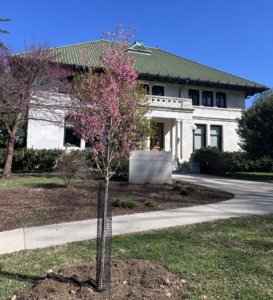
The sapling in front of the Visitor Education Center planted by Casey Trees in early March.
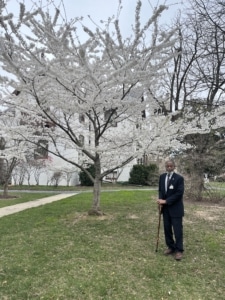
George Wellman in front of a Yoshino cherry tree in bloom by the Cottage, March of 2024
George Wellman has been a resident of the Armed Forces Retirement Home since 2006. He traces his love of trees to helping his parents, who were sharecroppers in North Carolina, with logging in the days before his military career. Over the years, he has been a great friend to President Lincoln’s Cottage. Today he loves to explore the campus, taking pictures and composing poems.





